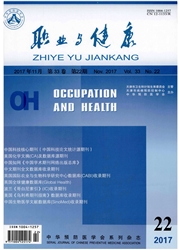

 中文摘要:
中文摘要:
目的通过研究不同粒径及不同浓度纳米氧化铝颗粒对中国仓鼠肺细胞(CHL细胞)DNA损伤及氧化应激的影响,探索纳米氧化铝颗粒遗传毒性及作用机制。方法选用13、50nm和10斗m3种粒径的氧化铝颗粒为3个粒径组,每种粒径氧化铝又分别设低剂量(15μg/ml)、中剂量(30μg/ml)、高剂量(60pg/m1)组,另设空白对照组和阳性对照组。染毒24h后处理细胞。用荧光显微镜观察cy5.5荧光标记纳米颗粒进入细胞的情况。用单细胞琼脂糖凝胶电泳(SCGE)检测DNA损伤,谷胱甘肽(GSH)、超氧化物歧化酶(SOD)、丙二醛(MDA)评估氧化应激反应的指标。结果荧光标记的纳米颗粒在细胞核周围分布。SCGE结果显示,与空白对照组相比,各染毒剂量组Olive尾矩有增加趋势,中、高剂量组Olive尾矩均明显增加(P〈0.05)。氧化应激指标结果显示,随着染毒剂量的增加各种氧化应激指标明显变化,高剂量组与空白对照组相比,差异有统计学意义(P〈0.05)。结论纳米氧化铝颗粒可以引起CHL细胞DNA损伤和氧化应激反应,氧化应激反应可能是导致遗传毒性的机制之一。
 英文摘要:
英文摘要:
[ Objective] To analyze the genotoxicity and mechanism of alumina nanoparticles by detecting DNA damage and oxidative stress changes in Chinese hamster lung cells ( CHL cells ) induced in Vitro at different size and different concentration of alumina nanoparticles. [ Methods] Alumina nanoparticles (13 nm and 50 nm) and alumina microparticles (10 μm) were selected. CHL cells were separated into 5 groups: blank control group, low-dose group (15 μg/ml), medium-dose group (30μg/ml), high-dose group (60μg/ml) and positive control group. All the cells were treated for 24 h. Cy5.5 fluorescent labeled nanoparticles was ob- served under a fluorescence microscope. DNA damage was detected by single cell agarose gel electrophoresis ( SCGE ). Glutathione (GSH) , superoxide dismutase (SOD) and malondialdehyde (MDA) were used to assess oxidative stress response. [ Results] The fluorescent labeled nanoparticles distributed around the nucleus. SCGE results suggested that, compared with the blank control group, Oliver tail moment showed a rising trend in different experimental groups, and that increased significantly in both mediumdose and high-dose groups ( P 〈 0.05 ). The results of oxidative stress response showed that oxidative stress indicators had significantly changed with the increment of nanoparticle doses, and that in the high-dose group had statistically significant as compared with that in control group {P 〈 0.05). [ Conclusion] Alumina nanoparticles can cause DNA damage and oxidative stress in CHL Cells, and oxidative stress might be one of the mechanisms that induce genotoxicity.
 同期刊论文项目
同期刊论文项目
 同项目期刊论文
同项目期刊论文
 期刊信息
期刊信息
